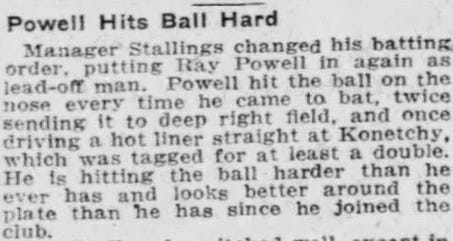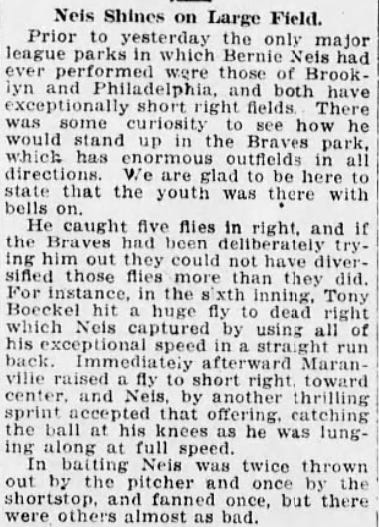26 Innings
I’ve never seen an advertisement for a baseball game that was more apt than this one:
Not one of the small crowd of 4,000 fans that bothered to show up at Braves Field that Saturday afternoon could have predicted the “big things” they would see that day.
It was an event unlike any other — and one that we know for certain will never be repeated.
This shouldn’t have been a remarkable game. The Boston Braves were a horrible club. The Brooklyn Robins, or Dodgers, or whatever you want to call them were at least in the pennant race. Boston hadn’t even played 10 games yet, and yet the team was already struggling just to break even.
The Braves had managed to beat Brooklyn the afternoon before. Hugh McQuillan threw a complete game shutout.

George Stallings, the manager who had helped the Braves to that miracle season of 1914, had decided to mix up the lineup a bit for that Friday afternoon game:
For Brooklyn, meanwhile, rookie right fielder Bernie Neis proved that he could handle the large pasture he had to cover in massive Braves Field:
And, well, that’s about it. It was another regular season game — and the game on Saturday, May 1, looked like it would be just like any other game.
It started at 3 PM, which was the regular starting time in those days even for weekend games.
And, well, what happened was the stuff of lore.
In a game that lasted almost 4 hours and broke just about every record imaginable, the two teams finished at a 1-1 tie after an incredible 26 innings.
I’m not entirely sure when the sun set on May 1, 1920 in Boston. I’ve got to guess that it was going down around 6:45 or 6:50 PM. Assuming this game actually started right at 3, it apparently lasted until the last flicker of daylight disappeared.
The game was remarkable for so many reasons that it’s hard to figure out even where to start. Ray Powell, the new leadoff hitter for Boston, went 1 for 7 with 3 walks, knocking his batting average down to a whopping .140. Bernie Neis for Brooklyn was in the number 2 spot in the lineup, where he managed to go 1 for 10, sinking his average down to .188.
It’s not like anybody else was hitting, of course. Brooklyn only managed 9 hits in 85 at bats, drawing a mere 4 walks in 26 innings. Boston had 15 hits — a somewhat more respectable total, given its 86 at bats. It managed to draw only 5 walks (according to Baseball Reference, that is; the original boxscore listed only 4).
The craziest thing of all, though, was the fact that both pitchers went the distance.
Leon Cadore of Brooklyn was 28 years old in 1920, and had just come off an excellent 1919 season. Cadore had gone 14-12 with a 2.37 ERA in 1919, and had one of those seasons that the modern pitching statistic fans love: a FIP of 2.54, a WHIP of 1.065, and a strong ERA+ of 125.
Cadore entered the May 1 game with a 2-1 record: 2 complete game wins, including a 1-0 11 inning shutout victory at home against Boston on April 20th. Leon had most recently been shelled by the hated New York Giants, however, getting knocked out in the 6th inning after giving up 5 runs.
Cadore took a full week off after this marathon, but kept pitching. He ended the season with 16 complete games and a 15-14 record, good enough to help Brooklyn to a National League pennant. He had two more fine seasons with Brooklyn, and then bounced around a little before ending his major league career with the Giants in 1924 at age 32.
Joe Oeschger wasn’t going to let Leon Cadore outdo him, of course.
Oeschger also went the full 26 innings. Heck, both of these guys probably would have kept on going if they had lights to turn on, or if someone wiser had realized that Saturday games could have started earlier than 3.
Like Cadore, Oeschger was 28 in 1920, though his 1919 season wasn’t quite as impressive. He managed a 4-4 record and a 3.94 ERA while playing for three different teams. He had previously led the National League in losses for the awful 1918 Philadelphia Phillies, going 6-18 in an era when losing a ballgame as a starting pitcher actually meant something.
Oeschger also had a 2-1 record going into this game, though all three of his decisions had been complete games. His one loss, incidentally, was a 1-0 loss in 11 innings at Brooklyn — the same game that Cadore had won.
Oeschger took almost 2 weeks off before his next start, but finished up the whole season just the same. He wound up with 20 complete games and an impressive 15-13 record for an awful Braves team. He had 3 more strong seasons for Boston and a stint as a reliever for a few teams for a few more years before retiring in 1925 at age 33. And, of course, the greatest irony of all is that he ended his career playing for none other than Brooklyn.
The weather wasn’t great, which makes you wonder how in the world they managed to keep the game going for 4 hours.
It’s actually not clear that there were as many as 4,000 fans there. Baseball Reference assures us that the attendance was actually 4,500, though I’m not sure what the source is. The Brooklyn Eagle contends that the attendance was about 2,500 due to the frigid weather:
Other papers claim the attendance was even smaller:
And, as far as the game goes — there were more amazing plays and crazy situations than you can believe.
We’ll never see anything like it again, of course. This foolishness of ghost runners and other ridiculous rules has put a stop to that.
But we still have our old newspaper accounts — and the great old drawings to remind us of what once was.



















I save every drawing like this I run across in my work. They don't all get used in pieces but I think I'm doing posterity a service by digging them out and keeping them from being buried again.
Truly enjoy reading these posts showcasing the writings/drawings of the past.